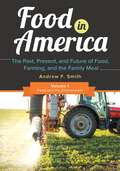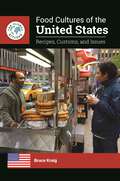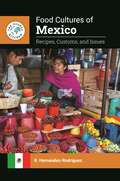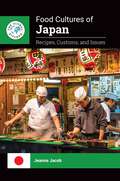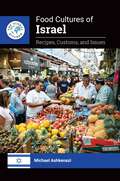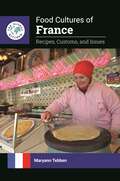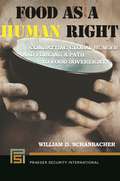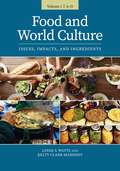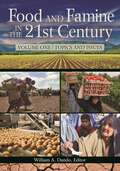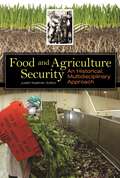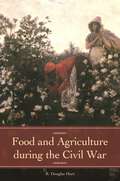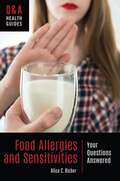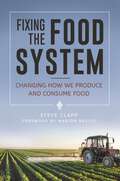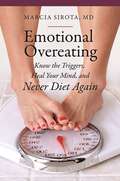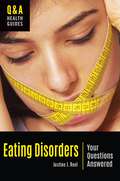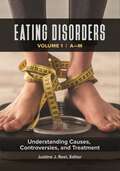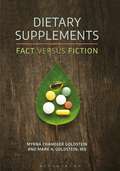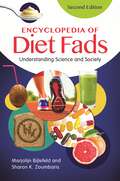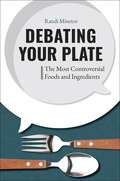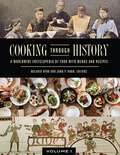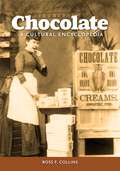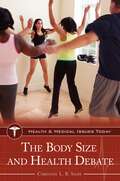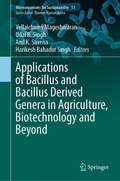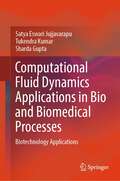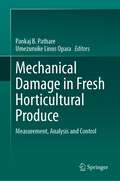- Table View
- List View
Food in America [3 volumes]: The Past, Present, and Future of Food, Farming, and the Family Meal [3 volumes]
by Andrew F. SmithThis three-volume work examines all facets of the modern U.S. food system, including the nation's most important food and agriculture laws, the political forces that shape modern food policy, and the food production trends that are directly impacting the lives of every American family.Americans are constantly besieged by conflicting messages about food, the environment, and health and nutrition. Are foods with genetically modified ingredients safe? Should we choose locally grown food? Is organic food better than conventional food? Are concentrated animal feed operations destroying the environment? Should food corporations target young children with their advertising and promotional campaigns? This comprehensive three-volume set addresses all of these questions and many more, probing the problems created by the industrial food system, examining conflicting opinions on these complex food controversies, and highlighting the importance of food in our lives and the decisions we make each time we eat.The coverage of each of the many controversial food issues in the set offers perspectives from different sides to encourage readers to examine various viewpoints and make up their own minds. The first volume, Food and the Environment, addresses timely issues such as climate change, food waste, pesticides, and sustainable foods. Volume two, entitled Food and Health and Nutrition, addresses subjects like antibiotics, food labeling, and the effects of salt and sugar on our health. The third volume, Food and the Economy, tackles topics such as food advertising and marketing, food corporations, genetically modified foods, globalization, and megagrocery chains. Each volume contains several dozen primary documents that include firsthand accounts written by promoters and advertisers, journalists, politicians and government officials, and supporters and critics of various views related to food and beverages, representing speeches, advertisements, articles, books, portions of major laws, and government documents, to name a few. These documents provide readers additional resources from which to form informed opinions on food issues.
Food Cultures of the United States: Recipes, Customs, and Issues (The Global Kitchen)
by Bruce KraigThis comprehensive volume examines the history of American food culture and cuisine today, from staple ingredients to dietary concerns.Everyday, without realizing it, Americans plan their days around food—what to make for dinner, where to meet for brunch, what to bring to a party. As a nation of immigrants, the U.S. has food and foodways that few countries in the world have. This addition to the Global Kitchen series examines all aspects of food culture in the United States, from the early Colonial period and Native American influences on the new immigrants' food to the modern era.The volume opens with a Chronology that looks at United States history and significant food events. Coverage then dives deep into the history of food in the U.S., and is followed by a chapter on influential ingredients in American cooking. Chapters break down American cuisine into appetizers and side dishes, main dishes, and desserts, looking at typical meals and flavors that characterize it. Additional chapters examine food eaten during holidays and on special occasions, street food and snacks, and restauarants. A final chapter looks at issues and dietary concerns. Recipes round out each chapter.
Food Cultures of Mexico: Recipes, Customs, and Issues (The Global Kitchen)
by R. Hernandez-RodriguezThis exciting volume brings to life the food culture of Mexico, detailing the development of the cuisine and providing practical information about ingredients and cooking techniques so that readers can replicate some of Mexico's most important traditional dishes.Mexican food has become one of the most popular cuisines in the United States, with noted dishes ranging from tacos and enchiladas to tamales and guacamole. What are the origins of Mexican food culture as we know it today?Written with an educated—not specialized—audience in mind, the book includes descriptions of traditional and high cuisine, regional and national foods, everyday dishes and those prepared and served on holidays and special occasions. It also discusses ancestral eating habits and the way the food has been transformed under the pressures of globalization.Specific chapters examine food history, important ingredients, typical appetizers, main meals, desserts, street foods and snacks, dining out, and food issues and dietary concerns. Recipes accompany every chapter. Rounding out the work are a chronology of food history, a glossary, sidebars, and a bibliography. This volume is ideal for any students learning about Mexican food and culture, as well as general readers who would like to learn more about international cuisines.
Food Cultures of Japan: Recipes, Customs, and Issues (The Global Kitchen)
by Jeanne JacobThis addition to the Global Kitchen series explores the cuisine of Japan, from culinary history and important ingredients to essential daily and special meals.When we think of Japanese food in the United States, certain images come to mind: sushi, ramen, and hibachi restaurants. But what is food like in this island nation? What do people eat and drink every day? Are food concerns similar to those in the United States, where obesity is a major issue?This volume offers comprehensive coverage on the cuisine of Japan. Readers will learn about the history of food in the country, influential ingredients that play an important role in daily cooking and consumption, meals and dishes for every occasion, and what food is like when dining out or stopping for snacks from street vendors. An additional chapter examines food issues and dietary concerns. Recipes accompany every chapter. A chronology, glossary, sidebars, and bibliography round out the work.
Food Cultures of Israel: Recipes, Customs, and Issues (The Global Kitchen)
by Michael AshkenaziThis volume explores cuisine in Israel, including the country's food culture history, important dishes, current food issues, and more.The evolution of Israeli food has been dependent on three major variables: the geography and climate of Israel, its ethnic mix and ethnic history (including religious influences, non-Jewish communities, and heavy immigration from around the world), and technical innovation that has enabled Israel to become a leader in agricultural technology.This book provides a comprehensive picture of Israeli food culture in the twenty-first century, examined on the basis of the various influences that created this particular culture. Such influences include the lengthy food history that can be traced to prehistory, including data from the Bible and Koran and archaeological evidence; as well as contemporary food practices that have emerged as a mix of influences from different ethnic groups. Modern Israeli food practices are the result of the sway of European, Middle Eastern, and other cultures, creating a cuisine that is marked by its blends. Main topics are accompanied by easy-to-follow recipes. The book serves as an introduction to daily life in Israel as well as the evolution of food practices in a relatively new country.
Food Cultures of France: Recipes, Customs, and Issues (The Global Kitchen)
by Maryann TebbenAs a comprehensive overview of French food from fine dining to street food and from Roman Gaul to current trends, this book offers anyone with an interest in French cuisine a readable guide to the country and its customs.In France, food is integral to the culture. From the Revolutionary cry for good bread at a fair price to the current embrace of American bagels and "French tacos," this book tells the full story of French food.Food Cultures of France: Recipes, Customs, and Issues explores the highs and lows of French cuisine, with examples taken from every historical era and all corners of France. Readers can discover crêpes from Brittany; fish dumplings from Lyon; the gastronomic heights of Parisian restaurant cuisine; glimpses of the cuisines of France's overseas territories in Africa and the Caribbean; and the impact of immigrant communities on the future of French food. Learn how the geography of France shaped the diet of its people and which dishes have withstood the test of time. Whether the reader knows all about French cuisine or has never tasted a croissant, this book will offer new insights and delicious details about French food in all its forms.
Food as a Human Right: Combatting Global Hunger and Forging a Path to Food Sovereignty (Praeger Security International)
by William D. SchanbacherThis important work addresses the difficult ethical issues surrounding the accessibility of food to all people as a human right, and not a privilege that emerges because of social structure or benefit of geography.Food sovereignty—the right of peoples to define their own chosen food and agriculture, free of monopolization or threats—is the path to stopping global hunger. This book approaches the topic from a solutions-based perspective, discussing concrete policy providing for sovereignty, or control, of one's own food sources as a solution that, while controversial, offers more promise than do the actions of international organizations and trade agreements. Providing access to safe, healthy food is an ethical responsibility of the world's nations, not just a right of the elite or wealthy.This book presses the need to formulate policies that address the problems of poverty and hunger on a more humane and meaningful level. Organized thematically, chapters are based on such topics as food security, food sovereignty, human rights, and sustainability that focus on the global food system. Specific case studies provide examples of global hunger and poverty issues. Taken in its entirety, the book informs readers of how their food consumption might negatively affect the global poor, while its concluding chapters offer solutions for alleviating problems in the global food system.
Food and World Culture [2 volumes]: Issues, Impacts, and Ingredients [2 volumes]
by Linda S. Watts Kelty Clark-MahoneyThis book uses food as a lens through which to explore important matters of society and culture. In exploring why and how people eat around the globe, the text focuses on issues of health, conflict, struggle, contest, inequality, and power.Whether because of its necessity, pleasure, or ubiquity, the world of food (and its lore) proves endlessly fascinating to most people. The story of food is a narrative filled with both human striving and human suffering. However, many of today's diners are only dimly aware of the human price exacted for that comforting distance from the lived-world realities of food justice struggles. With attention to food issues ranging from local farming practices to global supply chains, this book examines how food&’s history and geography remain inextricably linked to sociopolitical experiences of trauma connected with globalization, such as colonization, conquest, enslavement, and oppression.The main text is structured alphabetically around a set of 70 ingredients, from almonds to yeast. Each ingredient's story is accompanied by recipes. Along with the food profiles, the encyclopedia features sidebars. These are short discussions of topics of interest related to food, including automats, diners, victory gardens, and food at world&’s fairs. This project also brings a social justice perspective to its content—weighing debates concerning food access, equity, insecurity, and politics.
Food and Famine in the 21st Century [2 volumes]: [2 volumes]
by Andrew D. Lohman Andrew Walter Ann Myatt James Bharath Ganesh-Babu Bimal Kanti Paul Carl Haub Christina E. Dando Christine Drake Danny M. Vaughn Dawn M. Drake Deborah Greenwood Dennis Skelton Donald J. Zeigler Frederick L. Bein Gregory Gaston John J. Hidore Joyce V. Cadwallader Kacey Mayes Kathleen Lamb Kozenski Kausar F. Siddiqi Kay Weller Melissa Martin Michael W. Kerwin Paul M. Chandler Paul Mausel Richard Snow Robin Leichenko Samuel T. Ledermann Sara A. Blackburn Stephen Aldrich Stephen J. Stadler Vijay Lulla Wiley C. Thompson William A. DandoThis comprehensive two-volume encyclopedia examines specific famines throughout history and contains entries on key topics related to food production, security and policies, and famine, giving readers an in-depth look at food crises and their causes, responses to them, and outcomes.Famines have claimed more lives across human history than all the wars ever fought.This two-volume set represents the most comprehensive study of food and famine currently available, providing the broadest analysis of hunger and famine causes as well as a detailed examination of the ramifications of cultural and natural hazards upon famine.Volume one focuses upon 50 topics and issues relating to the creation of hunger and famines in the world from 4000 BCE to 2100, including an overview of how agriculture has evolved from primitive hunting and gathering that supported limited numbers of people to a worldwide system that now feeds over seven billion people. Volume two, entitled Classic Famines, begins with famines of the past, from 4000 BCE to 2100 CE, includes ten classic famine case studies, and concludes with predictions of famines we could see in the 21st century and beyond.
Food and Agriculture Security: An Historical, Multidisciplinary Approach (Praeger Security International)
by Justin KastnerThis work is a historical, multidisciplinary explanation of the complexities of the food system in the United States and around the world, spanning the beginning of the modern era to today's globalized, interconnected market.A revolution in food supply and trade has been ongoing for decades, although most American consumers have been unaware of these changes—after all, to the end buyer, the food seems the same at the supermarket. But today, a large percentage of our food and agricultural products are imported to our country, and the U.S. Department of Homeland Security has designated Food and Agriculture as a "Critical Infrastructure and Key Resources Sector." Cross-border cooperation is essential, given the volume of trade, the nature of testing required, and the importance of ensuring the safety of these products.This book examines our food system in its entirety, discusses threats to food and agriculture security in America and abroad, and covers trade policy issues and U.S.-specific regulations affecting the food supply chain security. Emerging models of cross-border cooperation in Food and Agriculture Security are also described.
Food and Agriculture during the Civil War (Reflections on the Civil War Era)
by R. Douglas HurtThis book provides a perspective into the past that few students and historians of the Civil War have considered: agriculture during the Civil War as a key element of power.The Civil War revolutionized the agricultural labor system in the South, and it had dramatic effects on farm labor in the North relating to technology. Agriculture also was an element of power for both sides during the Civil War—one that is often overlooked in traditional studies of the conflict. R. Douglas Hurt argues that Southerners viewed the agricultural productivity of their region as an element of power that would enable them to win the war, while Northern farmers considered their productivity not only an economic benefit to the Union and enhancement of their personal fortunes but also an advantage that would help bring the South back into the Union.This study examines the effects of the Civil War on agriculture for both the Union and the Confederacy from 1860 to 1865, emphasizing how agriculture directly related to the war effort in each region—for example, the efforts made to produce more food for military and civilian populations; attempts to limit cotton production; cotton as a diplomatic tool; the work of women in the fields; slavery as a key agricultural resource; livestock production; experiments to produce cotton, tobacco, and sugar in the North; and the adoption of new implements.
Food Allergies and Sensitivities: Your Questions Answered (Q&A Health Guides)
by Alice C. RicherAn easy-to-understand introduction to food allergies, sensitivities, and intolerances—unique but related conditions affecting many children and adults. The information, guidance, and resources offered make this a valuable tool for anyone struggling with negative reactions to certain foods.While many people think that any negative reaction after eating a food indicates an allergy, that's not the case. True food allergies, along with more common food intolerances and sensitivities, can produce a wide range of symptoms, from unpleasant bloating to life-threatening anaphylactic shock. What causes these conditions, and how can they be treated or managed? Why are certain foods, like peanuts and milk, more problematic than others? Why are food allergies on the rise, and is this only a problem in the industrialized world? Food Allergies and Sensitivities: Your Questions Answered, a part of Greenwood's Q&A Health Guides series, answers these and other questions related to this fascinating topic. Each book in this series follows a reader-friendly question-and-answer format that anticipates readers' needs and concerns. Prevalent myths and misconceptions are identified and dispelled, and a collection of case studies illustrates key concepts and issues through relatable stories and insightful recommendations. The book also includes a section on health literacy, equipping teens and young adults with practical tools and strategies for finding, evaluating, and using credible sources of health information both on and off the internet—important skills that contribute to a lifetime of healthy decision-making.
Fixing the Food System: Changing How We Produce and Consume Food
by Steve ClappAmerica's broken food system has provoked an outcry from consumer advocates seeking to align food policies with public health objectives. This book examines both sides of the conflict for solutions.Many believe that America's food system is in dire need of reform, with concerns ranging from the obesity epidemic to exploitative labor practices and negative environmental impact. This eye-opening book answers provocative questions about what changes are needed, who is advocating the changes, what parties are opposing these changes (and why), and what a new food system would look like. Organized into three sections, the work identifies the problems with the current system, reviews the changing landscape of food policy, and suggests workable solutions for progress.Washington insider Steve Clapp takes a comprehensive look at the struggle over the future of food. He examines the vision for a reformed national food policy that includes calculating the true cost of food, providing universal access to healthful food, adopting farm policies supporting public health and environmental objectives, improving food safety, paying fair wages to food employees, treating food animals with compassion, and reducing the food system's carbon footprint. The book explores the ways in which these issues can be resolved, drawing upon lessons learned from the early food advocates of the 1960s and 1970s.
Emotional Overeating: Know the Triggers, Heal Your Mind, and Never Diet Again (The Praeger Series on Contemporary Health and Living)
by Marcia Sirota M.D.This compelling book examines what causes compulsive eating, and provides methods for dealing with the emotional and psychological issues at the root of the problem.Weight loss has been a struggle for countless people in our food-obsessed culture; even achieving a healthy relationship with food is difficult for many Americans. Why is this? Respected author Marcia Sirota examines this phenomenon, exploring the emotional and psychological factors involved with overeating and food addiction. Emotional Overeating: Know the Triggers, Heal Your Mind, and Never Diet Again starts with the root cause of obesity and ends with practical techniques to find freedom from the urge to overeat. The author provides an overview of the overeating and obesity problem, offers a critical look at the downfalls of dieting, and reveals the reasons why many of us use food to supplant a real emotional need. The book includes numerous exercises and specific tools for healing, as well as an avenue to effortless permanent weight loss.
Eating Disorders: Your Questions Answered (Q&A Health Guides)
by Justine J. ReelThis book is an approachable introduction to eating disorders; one of the most common—and dangerous—forms of mental illness. The information, guidance, and resources offered make it a valuable tool for anyone struggling with issues surrounding food, weight, and body image.In the United States today, an estimated 20 million women and 10 million men meet the diagnostic criteria for an eating disorder, and millions more have disordered eating habits and a dysfunctional relationship with food. Whether their disorder is diagnosed or not, individuals struggling with these issues face serious and potentially lifelong physical and emotional consequences as a result of their behaviors. Eating Disorders: Your Questions Answered, a part of Greenwood's Q&A Health Guides series, provides clear, concise information for readers who want to learn more about these often misunderstood psychiatric illnesses. In addition to discussing the most common eating disorders, their consequences, and treatment, this book also explores how eating disorders develop and how they can be prevented.Each book in this series follows a reader-friendly question-and-answer format that anticipates readers' needs and concerns. Prevalent myths and misconceptions are identified and dispelled, and a collection of case studies illustrates key concepts and issues through relatable stories and insightful recommendations. The book also includes a section on health literacy, equipping teens and young adults with practical tools and strategies for finding, evaluating, and using credible sources of health information both on and off the internet—important skills that contribute to a lifetime of healthy decision-making.
Eating Disorders [2 volumes]: Understanding Causes, Controversies, and Treatment [2 volumes]
by Justine J. ReelThis encyclopedia offers a variety of resources for readers interested in learning more about eating disorders, including hundreds of reference entries, interviews, scholarly debates, and case studies.While many people may reflexively imagine an anorexic or bulimia teenage girl upon being asked to think about eating disorders, eating disorders are a form of mental illness that can take many forms and affect individuals of all genders, ages, and ethnic backgrounds. In fact, an estimated eight million people in the United States struggle with an eating disorder, making eating disorders one of the most prevalent forms of mental illness in America. This two-volume encyclopedia comprehensively examines eating disorders as the forms they can take; their causes and potential complications; and how they can best be treated and prevented. It also examines the influence had by cultural factors such as the fashion industry, television and movies, and social media. More than just a simple A-to-Z reference, Eating Disorders: Understanding Causes, Controversies, and Treatment also includes valuable features such as Q&A interviews with those affected by and working to combat eating disorders, case studies, scholarly essays that voice opinions in key debates, and a directory of resources for individuals seeking help.
Dietary Supplements: Fact versus Fiction
by Myrna Chandler Goldstein Mark A. MDThis accessibly written book examines the most commonly taken dietary supplements, exploring what they are and what they're purported to do, and summarizing key research findings regarding their potential health benefits and risks.Today, more than 50 percent of Americans take at least one type of dietary supplement regularly. But do these products actually work? How are they regulated? Are there any potential health risks? Dietary Supplements: Fact versus Fiction examines the most commonly used non-nutrient supplements (those that are neither vitamins nor minerals and not essential for human health). Using a standardized structure, each entry discusses a particular supplement's origins, purported benefits, potential risks, and common dosage. Summaries of key research studies are included to help readers make informed decisions about supplements' usefulness. Introductory materials give readers a foundational understanding of how supplements are regulated and labeled and offer practical information about how to read a Supplement Facts panel. For those interested in supplements for a particular health complaint (such as fatigue or pain), a topic finder has also been included.
Encyclopedia of Diet Fads: Understanding Science and Society
by Marjolijn Bijlefeld Sharon K. ZoumbarisThis updated encyclopedia examines the basics of nutrition and dieting, presenting the important people, concepts, and criticisms involved and examining the pros and cons of different plans.This A-to-Z reference describes many of the health fads and fashions of the past as well as current trends in weight loss to help people understand the principles of weight loss and the benefits of healthy choices. The authors help to identity effective means of losing weight and maintaining a healthy lifestyle, placing particular emphasis on weight-loss programs aimed at young people who struggle most with obesity, eating disorders, and body image. The book explores what works, what is potentially dangerous, and what scientists are discovering about nutrition, while also offering sustainable advice for keeping fit.The second edition of Encyclopedia of Diet Fads includes many updated, expanded, and completely new entries, as well as the latest information on diets and reviews many popular diet trends like the Atkins Diet, the Zone Diet, Weight Watchers, and Medifast. The book is organized by alphabetical entries regarding nutrition, exercise, and famous and infamous diet-promoters. Readers can learn more about an area that interests them through cross-referenced sections and a prolific list of additional resources. A selection of appendixes contains practical information such as how to evaluate diets and recipes.
Debating Your Plate: The Most Controversial Foods and Ingredients
by Randi MinetorThis book examines the most controversial foods and ingredients, providing an objective, well-balanced look at the health benefits and risks of each. It equips readers with the information they need to make their own informed decisions about what they eat.Most people aspire to eat healthy, but what exactly does that mean? While some foods are universally acknowledged as beneficial, such as many vegetables, and others are widely condemned, such as added sugar, many foods have a more controversial reputation.Debating Your Plate: The Most Controversial Foods and Ingredients offers in-depth coverage of some of the most hotly debated items on grocery store shelves and dinner plates. Each entry provides thorough background and contextual information before examining the unique issues and controversies that surround that food or ingredient. By presenting both sides of the argument in clear, unbiased language, the book allows readers to form their own opinions about which items to include in their diet and which to avoid. On a larger scale, the book also examines why nutrition science is so prone to controversy and ambiguity, and it offers readers guidance on how to evaluate health claims for themselves.
Cooking through History [2 volumes]: A Worldwide Encyclopedia of Food with Menus and Recipes [2 volumes]
by Melanie Byrd and John P. DunnFrom the prehistoric era to the present, food culture has helped to define civilizations. This reference surveys food culture and cooking from antiquity to the modern era, providing background information along with menus and recipes.Food culture has been central to world civilizations since prehistory. While early societies were limited in terms of their resources and cooking technology, methods of food preparation have flourished throughout history, with food central to social gatherings, celebrations, religious functions, and other aspects of daily life. This book surveys the history of cooking from the ancient world through the modern era.The first volume looks at the history of cooking from antiquity through the Early Modern era, while the second focuses on the modern world. Each volume includes a chronology, historical introduction, and topical chapters on foodstuffs, food preparation, eating habits, and other subjects. Sections on particular civilizations follow, with each section offering a historical overview, recipes, menus, primary source documents, and suggestions for further reading. The work closes with a selected, general bibliography of resources suitable for student research.
Chocolate: A Cultural Encyclopedia
by Ross F. CollinsChocolate is nearly always with us—when celebrating or mourning, in love or alone, healthy or sick, happy or sad. This book offers a comprehensive look at how an exotic food grew to play such a central role in our lives.No food in the world can offer as storied a history as chocolate. Chocolate: A Cultural Encyclopedia focuses on cocoa's history from ancient Mesoamerican beginnings as a symbol of ritual, life, and death, to its omnipresence in Europe, North America, and the rest of the world. In 10 thematic chapters covering chocolate in society and culture, 80 shorter entries, recipes, and a comprehensive timeline, this new book takes a closer look at how chocolate has served as a medicine, an indulgence, a symbol of decadence, a door to romance, a tempting taboo, a means of survival, and a snack for children and adults alike.Why did popes and kings so fear their chocolate? Who invented milk chocolate, and why was its formula kept secret? Why did soldiers in World War II despise their chocolate rations? Who makes the most chocolate today? Find out the answers to these questions and more as this book tells you everything you wanted to know—and a lot you didn't even know existed—about the seed from the world&’s favorite fruit tree.
The Body Size and Health Debate (Health and Medical Issues Today)
by Christine L. SelbyHas the connection between body size and overall health been overstated for decades? This book examines how our dogged efforts to eradicate obesity may be doing more harm than good and explores alternative ways to measure and encourage health.It's fair to say that Americans are obsessed with body size and weight—whether it's in the name of health and disease prevention or the idealization of unrealistically thin proportions. But trying to lose weight and drop clothing sizes is healthy, right? Or is it not healthy, in many cases?In this book, the latest in Greenwood's Health and Medical Issues Today series, Certified Eating Disorder Specialist and Certified Sport Psychology Consultant Christine L. B. Selby, PhD, examines the often confusing information—and misinformation—that exists on obesity and its connection to overall health. She provides a broad examination of this timely topic, addressing the rate of obesity in the United States, questioning the appropriateness of BMI to gauge overall health and well-being, discussing controversies related to weight and health including excessive dieting, and providing real-world scenarios that clearly illustrate major concepts related to weight and health. The book also summarizes a relatively new and still controversial approach to improving well-being that takes the focus off the number on the scale. But can individuals really be happy and healthy at any size
Applications of Bacillus and Bacillus Derived Genera in Agriculture, Biotechnology and Beyond (Microorganisms for Sustainability #51)
by Vellaichamy Mageshwaran Udai B. Singh Anil K. Saxena Harikesh Bahadur SinghThis edited volume provides a comprehensive view of the recent developments on Bacillus and their application in agriculture and allied sectors in a global scenario. Research articles sharing a consolidated state-of-the-art development in this area are solicited for this book. This book is a complete package covering all spheres of diversity and taxonomy, nutrient supplementation, biotic and abiotic stress management, biofilm and endophytic colonization, commercialization and regulatory mechanisms, etc. Descriptions of cutting-edge techniques and novel approaches on Bacillus research is also covered. A part of the book concentrates on the biotic and abiotic stress management in several important crops. It contains 11 contributory chapters from eminent experts in the field of life sciences specially microbiology, plant pathology and biotechnology working on different aspects of Bacilli and their application in agriculture and allied sectors. This book is useful for Graduate, Post-graduate students, research scholars, and post doctorate scholars of plant science, plant microbiology, soil microbiology and plant pathology discipline researchers, academicians, industrialists, policy makers.
Computational Fluid Dynamics Applications in Bio and Biomedical Processes: Biotechnology Applications
by Satya Eswari Jujjavarapu Tukendra Kumar Sharda GuptaThis book covers emerging areas in novel design and their hydrodynamic properties relevant to bioreactors, environmental system, electrochemical systems, food processing and biomedical engineering. This book uses an interdisciplinary approach to provide a comprehensive prospective simulation modeling and hydrodynamic study in advanced biotechnological process and includes reviews of the most recent state of art in modeling and simulation of flows in biological process, such as CFD. Written by internationally recognized researchers in the field, each chapter provides a strong introductory section that is useful to both readers currently in the field and readers interested in learning more about these areas.
Mechanical Damage in Fresh Horticultural Produce: Measurement, Analysis and Control
by Pankaj B. Pathare Umezuruike Linus OparaThis book includes the impact, compression, vibration studies, and destructive and nondestructive techniques for bruise measurement. It is essential to detect bruises in the early stages of their formation and conduct a quantitative analysis of the degree of bruising, to ensure the accurate grading of bruised fruits and vegetables and reduce unnecessary economic losses. Bruise damage occurring between the point of harvest and consumption contributes the most to the decrease in fruit quality, reducing the market value and ultimately leading to significant reductions in potential revenue. SDG 12.3 aims to “by 2030, halve per capita global food waste at the retail and consumer levels and reduce food losses along production and supply chains, including post-harvest losses.” This book presents recent technological developments in bruise measurement, detection, and analysis of fresh horticultural produce. Given the rising demand for rapid and accurate methods of quality measurement in the horticultural produce industry, this book covers destructive and nondestructive techniques for bruise measurement. Selected applications of different nondestructive methods for various fresh produce commodities are also included. This book will interest graduate and undergraduate students, researchers, academics and engineers working in different aspects of the mechanical damage affected by postharvest handling practices, professionals working in the governments, and other authorities related to fresh horticultural produce quality, regulations, and safety.
